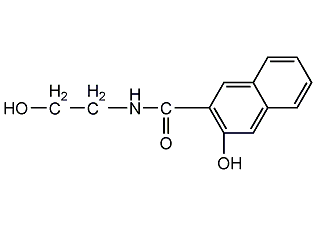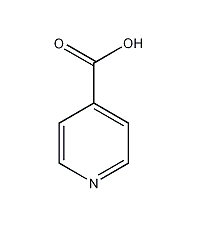
Structural formula
| Business number | 0258 |
|---|---|
| Molecular formula | C13H13NO3 |
| Molecular weight | 231.25 |
| label |
2-Hydroxy-3-[(2-hydroxyethyl)carbamoyl]naphthalene spheres, 2-Hydroxy-3-[(2-hydroxyethyl)carbamoyl]naphthalene |
Numbering system
CAS number:92-80-8
MDL number:None
EINECS number:202-191-8
RTECS number:None
BRN number:None
PubChem ID:None
Physical property data
1. Properties: light yellow to light yellow brown crystals or crystalline powder
2. Density (g/mL, 25/4?): Undetermined
3. Relative Vapor density (g/mL, air=1): Undetermined
4. Melting point (ºC): 146
5. Boiling point (ºC, normal pressure): Undetermined
p>
6. Boiling point (ºC, 5.2kPa): Not determined
7. Refractive index: Not determined
8. Flash point (ºC): Not determined
p>
9. Specific optical rotation (º): Undetermined
10. Autoignition point or ignition temperature (ºC): Undetermined
11. Vapor pressure (kPa , 25ºC): Undetermined
12. Saturated vapor pressure (kPa, 60ºC): Undetermined
13. Heat of combustion (KJ/mol): Undetermined
14. Critical temperature (ºC): Undetermined
15. Critical pressure (KPa): Undetermined
16. Log value of oil-water (octanol/water) partition coefficient : Undetermined
17. Explosion upper limit (%, V/V): Undetermined
18. Explosion lower limit (%, V/V): Undetermined
19. Solubility: Slightly soluble in water, soluble in ethanol, acetone
Toxicological data
None
Ecological data
None
Molecular structure data
1. Molar refractive index: 65.76
2. Molar volume (cm3/mol): 176.3
3. Isotonic specific volume (90.2K ): 495.7
4. Surface tension (dyne/cm): 62.4
5. Polarizability (10-24cm3): 26.07
Compute chemical data
1. Reference value for hydrophobic parameter calculation (XlogP): 2
2. Number of hydrogen bond donors: 3
3. Number of hydrogen bond acceptors: 3
4. Number of rotatable chemical bonds: 3
5. Number of tautomers: 9
6. Topological molecule polar surface area 69.6
7. Number of heavy atoms: 17
8. Surface charge: 0
9. Complexity: 269
10. Number of isotope atoms: 0
11. Determine the number of atomic stereocenters: 0
12. Uncertain number of atomic stereocenters: 0
13. Determine the number of chemical bond stereocenters: 0
14. Uncertain Chemistry?Number of stereocenters: 0
15. Number of covalent bond units: 1
Properties and stability
None
Storage method
This product should be sealed and stored in a cool, dry place.
Synthesis method
None
Purpose
Organic Synthesis.
extended-reading:https://www.newtopchem.com/archives/44359extended-reading:https://www.bdmaee.net/cas23850-94-4/extended-reading:https://www.newtopchem.com/archives/1010extended-reading:https://www.bdmaee.net/wp-content/uploads/2022/08/Toluene-diisocyanate-TDI-TDI-trimer.pdfextended-reading:https://www.bdmaee.net/delayed-catalyst-8154/extended-reading:https://www.bdmaee.net/wp-content/uploads/2020/06/59.jpgextended-reading:https://www.newtopchem.com/archives/44465extended-reading:https://www.newtopchem.com/archives/781extended-reading:https://www.cyclohexylamine.net/cell-improvement-agent-size-stabilizer/extended-reading:https://www.newtopchem.com/archives/45212




